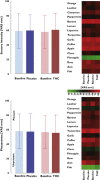Effects of 20 mg oral Δ(9) -tetrahydrocannabinol on the olfactory function of healthy volunteers
- PMID: 24802974
- PMCID: PMC4243870
- DOI: 10.1111/bcp.12415
Effects of 20 mg oral Δ(9) -tetrahydrocannabinol on the olfactory function of healthy volunteers
Abstract
Aims: Olfactory loss impairs the patient's quality of life. In individualized therapies, olfactory drug effects gain clinical importance. Molecular evidence suggests that among drugs with potential olfactory effects is Δ(9) -tetrahydrocannabinol (THC), which is approved for several indications, including neuropathic pain or analgesia in cancer patients. The present study aimed at assessing the olfactory effects of THC to be expected during analgesic treatment.
Methods: The effects of 20 mg oral THC on olfaction were assessed in a placebo-controlled, randomized cross-over study in healthy volunteers. Using an established olfactory test (Sniffin' Sticks), olfactory thresholds, odour discrimination and odour identification were assessed in 15 subjects at baseline and 2 h after THC administration.
Results: Δ(9) -Tetrahydrocannabinol impaired the performance of subjects (n = 15) in the olfactory test. Specifically, olfactory thresholds were increased and odour discrimination performance was reduced. This resulted in a significant drop in composite threshold, discrimination, identification (TDI) olfactory score by 5.5 points (from 37.7 ± 4.2 to 32.2 ± 5.6, 95% confidence interval for differences THC vs. placebo, -7.8 to -2.0, P = 0.003), which is known to be a subjectively perceptible impairment of olfactory function.
Conclusions: Considering the resurgence of THC in medical use for several pathological conditions, the present results indicate that THC-based analgesics may be accompanied by subjectively noticeable reductions in olfactory acuity. In particular, for patients relying on their sense of smell, this might be relevant information for personalized therapy strategies.
Keywords: cannabinoids; olfaction; sensory pharmacology; Δ9-tetrahydrocannabinol.
© 2014 The British Pharmacological Society.
Figures


 , placebo;
, placebo;  , THC
, THC
 , placebo;
, placebo;  , THC; *** P = < 0.001
, THC; *** P = < 0.001References
-
- Ackerman BH, Kasbekar N. Disturbances of taste and smell induced by drugs. Pharmacotherapy. 1997;17:482–496. - PubMed
-
- Doty RL, Philip S, Reddy K, Kerr KL. Influences of antihypertensive and antihyperlipidemic drugs on the senses of taste and smell: a review. J Hypertens. 2003;21:1805–1813. - PubMed
-
- Henkin RI. Drug effects on smell and taste. In: Pradham SN, Maickel RP, Dutta SN, editors. Pharmacology in Medicine: Principles and Practice. Bethesda: SP Press Int; 1986. pp. 748–753.
-
- Henkin RI. Drug-induced taste and smell disorders. Incidence, mechanisms and management related primarily to treatment of sensory receptor dysfunction. Drug Saf. 1994;11:318–377. - PubMed
-
- Schiffman S. Drugs influencing taste and smell perception. In: Getchell TV, Doty RL, Bartoshuk LM, Snow JB, editors. Smell and Taste in Health and Disease. New York: Raven Press; 1991. pp. 845–850.
Publication types
MeSH terms
Substances
LinkOut - more resources
Full Text Sources
Other Literature Sources
Medical

